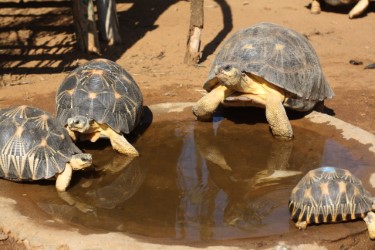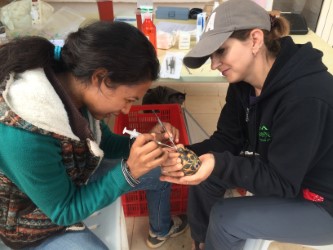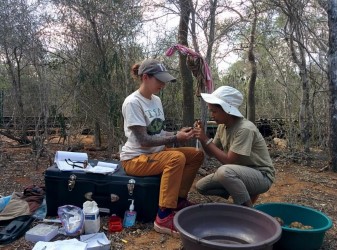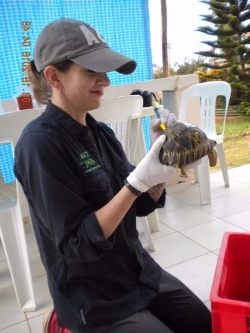Interview with TSA’s Sheena Koeth
by Howard Goldstein 

Sheena Koeth is the Veterinary Care Manager for TSA, and has spent the last half of August in Madagascar, visiting and evaluating TSA’s tortoise confiscation centers.
Q: What were the goals of this trip?
I went to southern Madagascar to assess four different facilities that we oversee and to mentor the veterinarian in tortoise medical care techniques. I worked especially closely with Ny Aina Tiana Rak, the vet for TSA Madagascar, whom I was with constantly for the entire trip. Animals are often in poor condition when they arrive at our triage centers, and I helped Ny Aina recognize more signs of illness and injury and how to treat them with the available resources. In places like Madagascar, it can be very hard to get medications, electricity, water etc., and we need to work effectively with what we CAN do and what we DO have. Even simple things like providing adequate cover or shade can make a huge difference, especially to recovering animals. We focused heavily on ways to reduce stress on the animals. Managing to minimize stress is always management for better health, in all animals.
Q: Describe the conditions of the confiscated tortoises that make it to TSA triage centers.
The tortoises have been through a trauma, sometimes for an extended period of time. They’ve been taken from the wild, piled on top of one another, shoved into sacks and suitcases, etc. Sometimes traffickers tape the animals' legs in so they can't extend them from the shell. This inhibits their ability to breathe properly, as does being left upside-down for any period of time (like in a suitcase) which puts the weight of the organs on the lungs. At confiscation, the animals frequently suffer from extreme stress, dehydration, starvation, skin infections, systemic infections, and potential exposure to new pathogens. Sadly, even after rescue, there is always a percentage of loss. For some it is simply too late. Most confiscated animals survive and recover, however.



Q: What kinds of maladies do you most often see, and how do you treat them?
Stress, dehydration, and starvation are big problems, and they often lead to additional problems such as suppression of the immune system and development of skin, shell, mouth, and systemic infections. Some have pneumonia, some are septic, etc. Parasite loads that are of little harm in the wild can wreak havoc on a compromised turtle. Often when they first come in, they have their eyes closed and don’t move much. They will literally waste away and die unless action is taken; they are simply too weak. For most animals suffering any level of dehydration, we start with giving subcutaneous fluids. After they rehydrate, they might begin eating again, but sometimes starving animals must be force fed repeatedly in order to get fuel into them and to kick start the gastrointestinal system again. It's difficult because you want to reduce handling of the animals to avoid extra stress, but they actually need to be handled a lot during supportive care. Eventually, these animals will start feeding again on their own as health problems resolve. For infections, I provided Ny Aina with some medications she has no access to in Madagascar, and also showed her how best to utilize meds that are available. I also helped teach her how to remove infected deep skin lesions and clean and treat the wounds. Ny Aina was able to see the results of our procedures quickly, and it was obvious how much better the animals looked just days later… a very rewarding experience.
Another issue is possible exposure to exotic pathogens, especially for animals that have left the country. For example, we recently had an illegal shipment of radiated tortoises confiscated in India before being returned to Madagascar. What kind of exotic pathogens may these tortoises have picked up from Indian species or other animals that were poached? Animals contained in cramped containers will defecate and urinate on each other and can spend lengthy amounts of time trapped in their potentially infectious waste. I worked with Dr. Robert Moore, a veterinarian with the Wildlife Conservation Society/Bronx Zoo, who went to Madagascar to obtain biological samples for pathogen testing. We took lots of samples, as it will be important to learn what native wild tortoises carry, what pathogens might have made it into Madagascar from confiscated animals, and how these things may affect Malagasy tortoises. Viruses, bacteria, and single celled organisms affecting turtles are only just beginning to be understood by science.
Q: What was it like working with Malagasy vets?
A large part of my trip was helping Ny Aina practice handling tortoises and effectively recognizing and treating their illnesses and injuries with available resources, in addition to delivering medication and equipment. Ny Aina, is very enthusiastic, interested, and a hard worker. We were fast friends. During my visit, she learned some new techniques to administer care to tortoises, manipulate and restrain them for procedures, and draw blood. Now, she is very, very good at drawing blood. There was a lot of practice while we obtained samples.
Q: What are your evaluations and thoughts about the facilities you visited?
We visited four facilities, including the triage center near Antananarivoand the airport, and then traveled to the south to two more triage centers and the new Tortoise Conservation Center. I inspected the facilities, and will report about the conditions and what can be improved. Conditions can be primitive in Madagascar, especially in the south, and so much depends on using what is available to its greatest efficiency, while realizing that things like electricity, running water, and materials easily obtained in the US may be difficult or impossible to come by in rural Madagascar. The staffs are very dedicated however, and the tortoises are in great shape. The TCC does not yet have a hospital. We are currently designing one around the needs of the tortoises. The vets in Madagascar have basic veterinary training in hoofstock and domestic animal medicine, but, considering how uncommonly herpetological medicine is taught in the US, it is nonexistent in Madagascar. However, Ny Aina is very interested and has gone far above and beyond her basic training to specifically accommodate tortoises. Again, a major reason for this trip was to bring expertise and training to help provide the best care for these critically endangered tortoises. I also brought some laboratory supplies, educational literature, and a variety of devices that we can use to manipulate tortoises.
Q: Can you describe what it’s like to travel in southern Madagascar?
Rough and fun! Southern Madagascar is not for people who aren’t well traveled in developing countries, and definitely not anyone who is high maintenance! It was loads of fun. I started my trip in Antananarivo and visited the nearby triage center, which is the first to receive tortoises confiscated at the airport. Then, I went to the facilities in the south, where the tortoises are dispersed after rehabilitation. This was a full day of flying, followed by a full day of driving just to reach the first facility. Long hours on the bumpiest roads I never knew existed. Very simple accommodations in the south as well; at times no electricity, no running water. Not anything that would bother a field biologist or someone experienced in conservation medicine. Regular folks would not enjoy it too much. Another nice thing…I found the men in Madagascar to be gentlemen, and ran into none of the harassment a female traveler endures in so much of the world. I mention it because I am well-travelled, and it is sadly uncommon.
Q: How have TSA facilities improved things for tortoises in Madagascar?
TSA and its facilities has been a true life saver for Malagasy tortoises. To visit these facilities and see the sheer number of tortoises that are alive and well because of hard work and dedication is amazing. Because of TSA they did not become property, or ornamentation, or food, or "medicine". These facilities now treat and house thousands of radiated tortoises, with most ultimately destined to be released back into the wild. Eventually, most tortoises will end up at the TCC, which is in a protected wild habitat. TSA has also made a huge difference in local communities, organizing and inspiring local people to take pride in their tortoises and to not tolerate poaching. TSA helped organize a Dina, or locally enacted civil law, amongst villages in the south to respect their own longstanding taboo against harming tortoises and to actively protect them.
Q: What still needs to be done?
The last minute collaboration with WCS for pathogen sampling took a lot of time, so I will need more time hands on to continue what we started. Ny Aina and I need to spend more time on cytology, fecal samples, and examining blood samples. Currently there are no veterinary facilities of any kind**, so we have to create the space to work in. Ny Aina wants to learn more advanced techniques, and more about recognizing and handling various health concerns. We went over necropsies and taking samples for histopathology but like many things we touched on, practice with a mentor will be important. They need more equipment and I need more time to continue training. One thing we will continually work on is the off-label use of drugs. Off label means that the drug is not labeled or approved for turtles (no medication is specifically manufactured for turtles!), so it's important to know how to use human and other animal medications that will work safely on tortoises. We only learn this kind of information from sharing with each other. I’ve helped Ny Aina become familiar with more options for medication that are available in Madagascar, and how to use them.
Q: How would you describe the trip overall?
A fantastic experience. I was thrilled to go and share some of my skills. Traveling to help animals is one of my favorite things in life. I learned a lot too! The people of Madagascar are lovely, all smiles and handshakes, whether they speak English or not. It was great to tour the facilities, work with the staff, and most of all, to see so many saved tortoises and to know that my actions are helping them.
**Editor’s note: Hopefully when Sheena returns she will find a new tortoise hospital to work in at the Tortoise Conservation Center. The British Chelonia Group (BCG) is currently raising funds to support the construction of this facility, which will include quarantine and treatment space, and we have a design plan ready to go.
